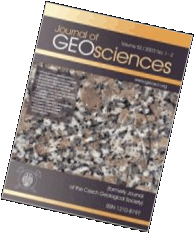 Export to Mendeley
Export to MendeleyOriginal paper
Calcium-rich dravite from the Arignac Gypsum Mine, France: Implications for tourmaline development in a sulfate-rich, highly magnesian meta-evaporite
Journal of Geosciences, volume 67 (2022), issue 2, 191 - 207
DOI: http://doi.org/10.3190/jgeosci.352
Tourmaline occurs in a wide range of compositional environments, but its occurrence in meta-evaporites is less commonly investigated. Highly magnesian (XMg = 0.90-0.98), poikiloblastic tourmaline occurs in a sulfate-rich, anhydrite-gypsum-bearing meta-evaporite in the Arignac Gypsum Mine, France and preserves a petrologic record of this unusual geochemical environment. Originally a Triassic evaporite deposit, the sample is interpreted to have undergone high-temperature-low-pressure (HT-LP) metamorphism and subsequently experienced low-grade, highly deformed overprints. Poikiloblastic tourmaline preserves relicts of the HT-LP mineral assemblage, as inclusions of anhydrite, phlogopite, dolomite, tremolite, Cl-rich scapolite (71-85 % marialite component), rutile, zircon, and fluor-apatite. The low-grade deformational overprints are characterized by partial replacement of anhydrite by gypsum, phlogopite by clinochlore, dolomite by talc, and scapolite by mixtures of near end-member albite and K-feldspar with later crosscutting calcite and celestite. Tourmaline develops two textural zones - zone 1 with few mineral inclusions and zone 2 with abundant inclusions and/or complex chemical zoning.
The tourmaline is mostly dravite or Ca-rich (> 0.25 apfu Ca) dravite with a few analyses of oxy-dravite and one attaining a high-Ti composition consistent with the hypothetical species “magnesio-dutrowite”. The average zone-1 tourmaline has an ordered structural formula of (Na0.61 Ca0.32 ☐0.07) (Mg2.82 Fe3+0.11 Ti0.06) (Al5.87 Fe3+0.13) (Si5.93 Al0.07) (BO3)3 (OH)3 (OH0.51 O0.41 F0.07) and the average zone-2 tourmaline has an ordered structural formula of (Na0.72 Ca0.21 ☐0.07) (Mg2.80 Ti0.20) (Al5.76 Fe3+0.17 Mg0.07) (Si5.91 Al0.09) (BO3)3(OH)3 (OH0.57 O0.39 F0.04). Inter- and intragranular chemical variability observed in the tourmaline is primarily consistent with the operation of combinations of the (CaMg)(NaAl)-1, (R3+O)[R2+(OH)]-1 and (TiO2)[R2+(OH)2]-1 exchange vectors.
Assuming 600 °C for tourmaline formation, the Na-Ca contents of the X-site yield fluid composition estimates of Na1+fluid of 480 mM and Ca2+fluid of 160 mM for average zone-1 and Na1+fluid of 460 mM and Ca2+fluid of 110 mM for average zone-2. Na is comparable to modern seawater, with Ca increased at least ten times. Partition coefficients involving aqueous fluids in equilibrium with tourmaline suggest that the dissolved constituents of the coexisting aqueous fluid were 144.7 ppm B, 3.0 ppm Cr, 8.6 ppm Mn and 53.6 ppm Ti for zone 1 compared to 145.4 ppm B, 0.7 ppm Cr, 13.6 ppm Mn and 16.6 ppm Ti for zone 2. Comparison of the Arignac tourmaline data with other meta-evaporites and sulfate- or scapolite-bearing lithologies demonstrate the remarkable commonalities and a few differences exhibited by tourmalines of these lithologies. These data contribute to our understanding of Mg-rich tourmaline formation and coexisting fluid compositions, require a modification of the AFM host rock compositional fields, and underscore the breadth of environments in which tourmaline forms.
Webdesign inspired by aTeo. Hosted at the server of the Institute of Petrology and Structural Geology, Charles University, Prague.
ISSN: 1803-1943 (online), 1802-6222 (print)
email: jgeosci(at)jgeosci.org


IF (WoS, 2024): 1.3
5 YEAR IF (WoS, 2024): 1.4
Policy: Open Access
ISSN: 1802-6222
E-ISSN: 1803-1943